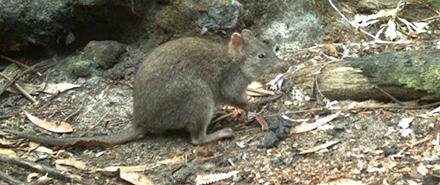 Camera monitoring of far East Gippsland’s forests after the fires has resulted in some great news about native wildlife survival. Source: Bombala Times
Camera monitoring of far East Gippsland’s forests after the fires has resulted in some great news about native wildlife survival. Source: Bombala Times
Southern Ark Operations manager, Andy Murray said: “We’ve had cameras out in the bush at 249 sites since April to check on the wildlife and their survival after the fires.
“We’re particularly interested in how the long-footed potoroos have fared – they’re an endangered species confined to forested country in East Gippsland and North-East Victoria and we weren’t sure about their ability to survive widespread and intense bushfires.
“The fantastic news is that the camera-trapping survey carried out from April to August revealed that we still had long-footed potoroos at 140 of the 249 sites, which is around 57% of the sites surveyed. When we surveyed in 2016/2017, the potoroos were detected at 64% of these sites, so fortunately there hasn’t been a catastrophic decline following the fires.
“They were also detected right across their known distribution in far East Gippsland, which should make it easier for the species to re-populate the forest as it recovers, and the potoroo numbers increase.
“The cameras also recorded the presence of a range of other mammal and bird species: mountain and common brushtail possums were surprisingly common, detected at 82 per cent of sites post-fire.
“Superb Lyrebirds were detected at 42% of the sites, common wombats and swamp wallabies were seen by around 47% of the cameras. Long-nosed bandicoots, bush rats, antechinus and ringtail possums also popped up from time to time.
“This news is both a relief and a reward for the extensive fox control program that preceded the fires. The fox baiting component of the Southern Ark project has been significantly re-established, with around 95% of the network now re-baited. Work continues to re-establish the rest of the network as more tracks are opened up.”







